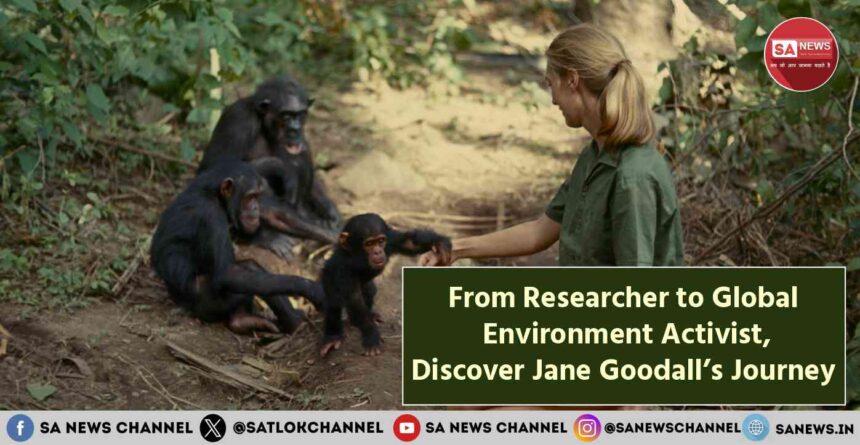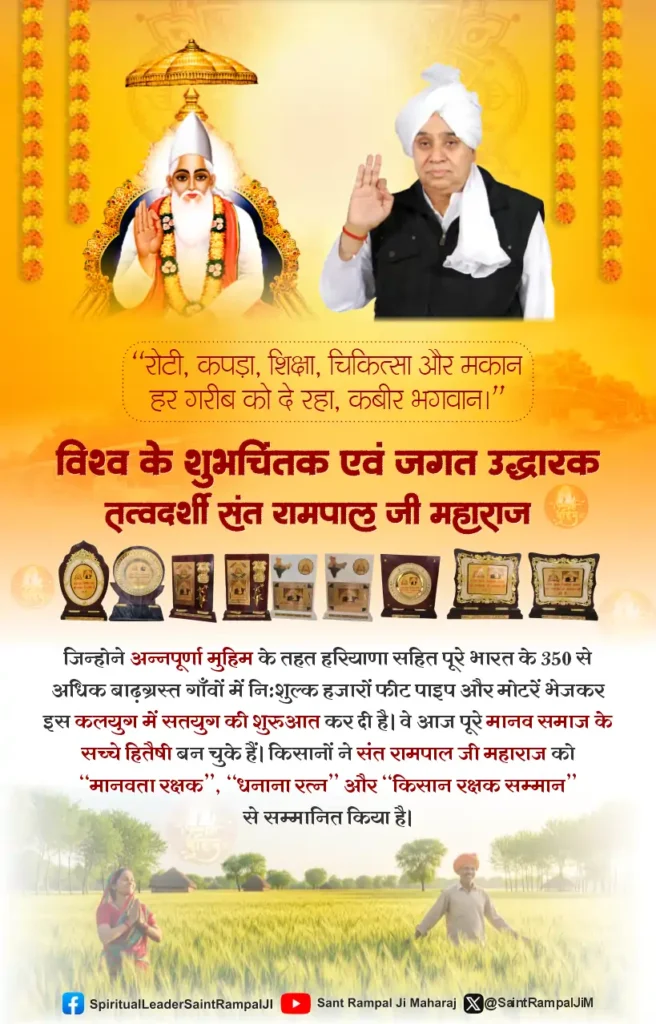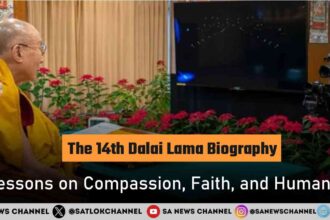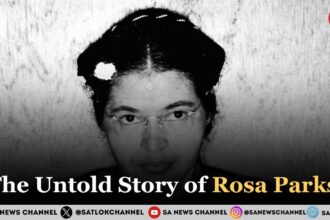We all are amazed by the intelligence exhibited by the Chimpanzees. Aren’t we?
- Biography of Jane Goodall: Early Life
- Biography of Jane Goodall: Education
- Meeting Louis Leakey
- Research on Chimpanzees
- Major Scientific Contributions
- Personal Life
- Love for the Passion
- Saint Rampal Ji Maharaj can end the Cycle of Birth and Death
- Biography of Jane Goodall: FAQs
- Question: Who is Jane Goodall?
- Question: What are the books written by Jane Goodall ?
- Question: What was the turning point in the life of Jane Goodall?
- Question: Who is Saint Rampal Ji Maharaj?
- Connect With Us on the Following Social Media Platforms
The way they think, act, behave among themselves and with other beings makes us deeply reflect on the fact that humans could have evolved from chimpanzees.
Do you know who is the first one to discover the tool usage, meat-eating behavior, and complex social structures of the chimpanzees? Jane Goodall is credited with the discovery of chimpanzees. She was successful in almost single handedly opposing the earlier scientific beliefs on chimpanzees. Delve into the blog to know the complete biography of Jane Goodall.
Biography of Jane Goodall: Early Life
Jane Goodall was born on April 3, 1934, in London, England, to Mortimer Herbert Morris-Goodall, a car-racing businessman, and Margaret Myfanwe Joseph, a novelist. From an early age, Goodall displayed a profound fascination with animals, which was encouraged by her mother.
Jane’s childhood was marked by unique moments, such as hiding in a henhouse for four hours at age 4 to observe how eggs were laid, and receiving a stuffed chimpanzee toy named ‘Jubilee’ from her father. Her childhood reading of books like ‘The Story of Doctor Dolittle’ and ‘Tarzan’ novels fueled her passion for African wildlife.
Biography of Jane Goodall: Education
Jane Goodall’s educational journey was unconventional yet remarkable. She went to the Upland School for her primary education. After leaving the Upland School at 18, she worked as a secretary and film production assistant to save money for her African dream.
Meeting Louis Leakey
In 1957, Jane’s life transformed when she met Louis Leakey, who recognized her passion for animals. Leakey sent her to London to study primate behavior with Osman Hill and primate anatomy with John Napier.
Biography of Jane Goodall: In 1962, without a prior undergraduate degree, Goodall was remarkably accepted into the University of Cambridge. She became the eighth person in the university’s history permitted to pursue a PhD without a bachelor’s degree.
At Newnham College, she earned her Bachelor of Arts in natural sciences by 1964 and completed her doctoral thesis in ethology by 1966, focusing on the Behaviour of free-living chimpanzees. Her groundbreaking research at Gombe Stream National Park formed the foundation of her academic credentials and future scientific contributions.
Research on Chimpanzees
Biography of Jane Goodall: Jane Goodall revolutionized primatology through her groundbreaking research at Gombe National Park, Tanzania, starting in 1960. She challenged scientific conventions by observing chimpanzees as individuals with unique personalities, naming them instead of numbering them. Her most significant discoveries included chimpanzees’ tool usage, meat-eating behavior, and complex social structures.
■ Also Read: Biography of Carl Sagan: Journey of an Astronomer to Know the Cosmos and the Extraterrestrial
Goodall revealed that chimpanzees make and use tools, hunt smaller primates, and demonstrate sophisticated emotional behaviors like compassion, sharing, and deep familial bonds. Her unconventional research methods and patient observations transformed our understanding of chimpanzees, demonstrating their remarkable similarities to humans and challenging the notion of human exceptionalism.
Major Scientific Contributions
Jane Goodall’s groundbreaking scientific works revolutionized primatology through her extensive research at Gombe Stream National Park. Her seminal publications include In the Shadow of Man (1971), which detailed her early observations of chimpanzee behavior, and The Chimpanzees of Gombe: Patterns of Behavior (1986), her definitive scientific work summarizing 25 years of research.
Goodall challenged scientific conventions by revealing that chimpanzees are omnivorous, capable of tool use, and possess complex social behaviors including warfare and emotional depth. Her research dismantled previous beliefs about animal behavior, demonstrating that chimpanzees hunt, make tools, and exhibit sophisticated emotional capacities. Her work was so transformative that Louis Leakey famously stated, “We must now redefine man, redefine tools, or accept chimpanzees as human!”
Personal Life
Jane Goodall’s personal life was marked by two significant marriages. In 1964, she married Baron Hugo van Lawick, a Dutch wildlife photographer who was originally sent by National Geographic to document her research. They had a son, Hugo Eric Louis (nicknamed “Grub”), born in 1967, and divorced in 1974. Her second marriage was to Derek Bryceson, a Tanzanian parliament member and national parks director, which lasted from 1975 until his death from cancer in 1980.
Biography of Jane Goodall: Throughout her marriages, Goodall maintained her scientific work and passion for chimpanzee research. Her first husband supported her work by photographing her research, while her second husband helped protect her research project through his position in the Tanzanian government. Interestingly, Goodall has noted that her observations of chimpanzee motherhood helped her understand human parenting, and her own experiences as a mother influenced her scientific perspectives.
Love for the Passion
After completing her groundbreaking chimpanzee research, Jane Goodall transformed into a global environmental activist. In 1986, a pivotal scientific conference marked her shift from researcher to advocate, prompting her to travel nearly 300 days annually. She founded the Jane Goodall Institute in 1977 and launched Roots & Shoots youth program in 1991, expanding her mission beyond scientific research.
Biography of Jane Goodall: Her later life focused on conservation, education, and animal welfare. She established the Tchimpounga Sanctuary for primates in 1992 and became a UN Messenger of Peace in 2002. Goodall has been recognized with numerous honors, including Dame Commander of the Order of the British Empire (2003), the Templeton Prize (2021), and the Presidential Medal of Freedom (2025).
Despite being near 90, she continues to be a powerful voice for wildlife protection, traveling globally and speaking out for those who cannot speak for themselves, emphasizing the interconnectedness of human and animal welfare.
Saint Rampal Ji Maharaj can end the Cycle of Birth and Death
In order to know about the creator of all universes including all living beings like apes, humans, plants listen to the satsang of Sant Rampal Ji Maharaj. Saint Rampal Ji Maharaj ji is the true saint in the world who can end the cycle of birth and death. The true way of worship given by Saint Rampal Ji Maharaj helps a devotee to achieve liberation.
To know more about Saint Rampal Ji Maharaj, read sacred books ‘Gyan Ganga’and ‘Way of Living’ by Saint Rampal Ji Maharaj. Readers can also take initiation from Saint Rampal Ji Maharaj by visiting www.jagatgururampalji.org.
Biography of Jane Goodall: FAQs
Question: Who is Jane Goodall?
Answer: Jane Goodall was a primatologist who did major groundbreaking discovery on Chimpanzees.
Question: What are the books written by Jane Goodall ?
Answer: The famous books written by Jane Goodall are ‘Shadow of Man’(1971) and ‘The Chimpanzees of Gombe: Patterns of Behavior’ (1986).
Question: What was the turning point in the life of Jane Goodall?
Answer: In 1957, Jane’s life transformed when she met Louis Leakey, who recognized her passion for animals. This was the turning point in the life of Jane Goodall.
Question: Who is Saint Rampal Ji Maharaj?
Answer: Saint Rampal Ji Maharaj ji is the true saint in the world who can end the cycle of birth and death.









